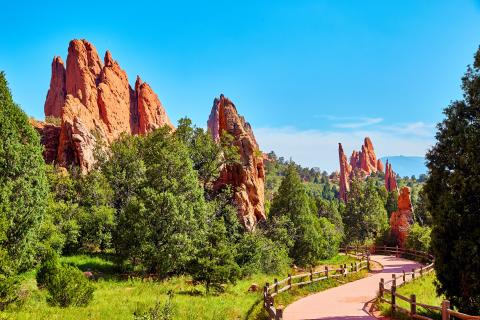Overview

In 2025, Colorado Springs Parks, Recreation and Cultural Services, Colorado Springs Utilities, the Colorado Springs Fire Department and the Office of Accessibility collaborated on a project to upgrade and enhance Garden of the Gods Park to increase safety and accessibility within the park.
The 8-month project involved the installation of 8,000 feet of new waterline and 9 fire hydrants to enhance fire and park safety and improve emergency response capabilities by ensuring a readily available water source for firefighters.
Additional improvements were also made to enhance accessibility with the creation of a fully accessible parking lot and ADA compliant trails into the Central Garden. Approximately 3,200 feet of asphalt was replaced to provide accessible parking nearer to the Central Gardens. A more sustainable, accessible concrete trail into Central Garden was also created, to eliminate barriers and allow everyone, regardless of ability, to enjoy the breathtaking sights of Garden of the Gods.
About

Garden of the Gods Park is a National Natural Landmark located in Colorado Springs, Colorado. It is a stunning geological formation made up of towering sandstone rock formations and home to a diverse array of plant and animal species, making it a popular destination for hikers, rock climbers, and nature enthusiasts. As the most visited attraction in the Pikes Peak Region, Garden of the Gods Park welcomes approximately 4.5 million visitors a year. While entry is free for all visitors, the Park nevertheless makes a significant impact on the local economy with a net contribution of $272 million annually.
Preservation of Garden of the Gods was of utmost importance during this construction project. The unique rock formations and delicate ecosystem were protected to ensure that future generations can continue to enjoy this natural wonder.
To minimize the impact of construction on the park, the construction team took extra steps to preserve the area including conducting thorough archaeological assessments before beginning construction, implementing erosion control measures to prevent soil runoff, and carefully monitoring any disturbance to the natural landscape.
A public information session was held on Wednesday, Aug. 14.
To minimize the impact of construction on the park, the construction team took extra steps to preserve the area including conducting thorough archaeological assessments before beginning construction, implementing erosion control measures to prevent soil runoff, and carefully monitoring any disturbance to the natural landscape.
Objectives:
- Enhance fire and park safety: The installation of 8,000 linear feet of waterline and 9 fire hydrants will ensure a readily available water source for firefighters, improving emergency response capabilities and park safety. This waterline will increase the water supply capacity ensuring a sufficient and reliable water source for firefighting purposes.
- Improve accessible parking: approximately 3,200 square feet of asphalt will be replaced to provide parking nearer to the Central Garden for persons with disabilities.
- Create more accessible routes: the project will replace a significant amount of the concrete path from Parking Lot #4 to the Central Garden and correct excessive slopes to provide a more easily navigable route between the two locations.
- Improve restroom facilities: The project aims to ensure a reliable water supply for park restrooms which will enhance the visitor experience.
